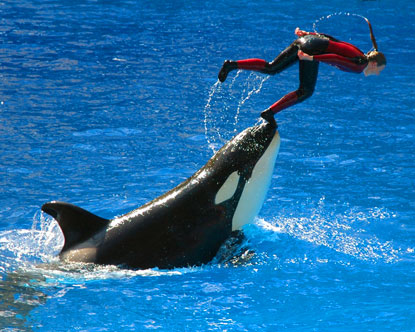By Kiara Catanzaro
News Assignment Editor
Did you ever visit SeaWorld when you were younger? Orcas perform tricks with trainers and their performances illustrate the life of an orca in captivity as harmless and even beautiful.
However, it is the exact opposite. “Blackfish,” a documentary directed and produced by Gabriela Cowperthwaite, tells the story of Tilikum, a male orca, and the harmful life that he has lived “working” at SeaWorld.
Beginning in the 1960s, orcas have been featured attractions at marine parks. Since then, more than 130 orcas have died in captivity. Several orcas have attacked trainers during their careers at SeaWorld. For example, Tilikum killed three trainers during his career.
I’m sure that you all think I’m crazy for siding with an orca, but SeaWorld is at fault for the deaths of their trainers. Animals held in captivity at SeaWorld live in a destructive environment.
Most orcas held in captivity suffer from a collapsed dorsal fin. Depressed whales will have wilted dorsal fins in captivity, whereas whales in the wild have dorsal fins that stand straight up.
Although Tilikum might never perform again, he’s still SeaWorld’s most productive breeder. He’s 30 years old and the only male in captivity. His purpose in life is to be a sperm donor for future orcas. His DNA is used for more than half of the whales that are raised at SeaWorld.
SeaWorld is responsible for going out and capturing whales and taking them away from their mothers, according to the documentary. Tilikum, who was taken away from his mother in Iceland, has been “working” at SeaWorld for his entire life. After Tilikum was placed in captivity, other female whales ruthlessly attacked him, according to the documentary.
SeaWorld trainers are responsible for teaching whales tricks for their performances. According to “Blackfish,” If an orca misses a cue for a trick or does the trick incorrectly, they are punished with starvation. It’s the equivalent of a student not being fed a meal because he or she didn’t get an A on a test. If that were the case, many students would go hungry on a daily basis.
Imagine living in a 20-foot-wide pool with no lighting for more than half of your life; I would be psychotic after a few hours, and these orcas live that way for their entire lives. It’s logical that orcas act out because life in containment isn’t the life they should live. Orcas were meant to live free in the ocean, not depressed in a pool-sized tub.
For more information about the story of Tilikum and the dangerous environment orcas live in at Seaworld, visit blackfishmovie.com and see the story that inspired the documentary.
Society should realize the harmful effects that captivity produces, not only for animals but also for the people who work with the animals in captivity.
catanzka12@bonaventure.edu






